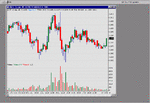Ha ! Ha! Ha! No, a shunt occurs when price action quietens down and there is plenty of time to do mischief to mislead by playing about with the bid and ask, so that it appears bullish but because the real intent is bearish because for example there is no real demand but orders do come in as purchases, then in order to further stimulate these orders to trap the unwary as weak holders the bid size is announced fractionally before the ask. Then that size is unloaded onto a willing buyer whose existence has not been revealed/announced. This is done very quickly and if you blink you miss it. It happens when prices are moving sideways with very very narrow spreads for some time. Then suddenly the real intent is revealed and prices begin to motor, either up or down.

